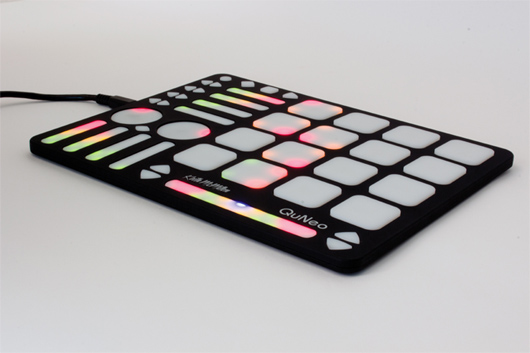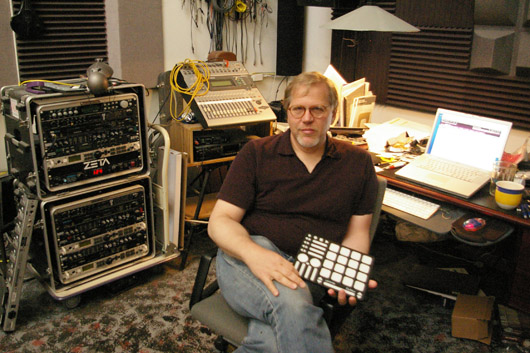Keith McMillen and the QuNeo
Curious about the recently released QuNeo controller, we talk with its creator to better understand […]

Curious about the recently released QuNeo controller, we talk with its creator to better understand the “3-D Multi-touch” surface.
Much in the same way that the internet and our ever-increasing access to technology has changed the worlds of music industry and production, those very same factors have altered the playing field for designers and manufacturers of production equipment in recent years, giving a growing power and visibility to smaller companies with more radical visions. Keith McMillen Instruments is one such company, headed by the decades-experienced designer who gives the operation its namesake, a brand which has spent the past seven years creating new tools that enhance the ways composers, performers, producers, and DJs interact with their computers. The latest product to emerge from Keith McMillen and his small-but-knowledgable crew is the QuNeo, an extremely portable contoller that seeks a balance between ease of use, enhanced musical expression, and endless customization—all in a unit with the exact same dimensions as an iPad.
Back in January, the idea for the controller was first proposed via a Kickstarter fundraising effort that eventually received overwhelming support, raising over $165,000 from almost 700 initial backers. After some unexpected delays in the manufacturing process, the controller reached its supporters’ hands as well as the shelves of stores last month. Among its impressive features, the QuNeo in its current state boasts a 4×4 grid of ultra-responsive pads that send nuanced X-Y location and pressure messages, or can alternately be used in “Grid Mode” to be utilized as 64 separate triggers, with each corner of the pads supplying a unique MIDI note. A quick glance at the QuNeo reveals some really smart features: a single USB port for both power and communication, a number of velocity-sensitive rotary sensors and sliders, and a robust LED system capable of supplying in-depth visual feedback. But perhaps most important of all is the freedom the controller seeks to give its user, essentially allowing its handlers to completely customize and implement its various capabilities at a variety of programming levels. As such, the QuNeo represents an intriguing technological step, one that empowers DJs and producers to, in a certain capacity, become designers of their own musical instruments. We were intrigued, and so decided to visit McMillen at his Berkeley headquarters to get a better sense of the concept behind the QuNeo and what all he thinks we can do with his latest creation.
Keith McMillen in his Berkeley, CA workshop

XLR8R: What was the inspiration for the QuNeo?
Keith McMillen: I’ve always been interested in how musicians interact with computers, that’s what I’ve spent my whole life studying and working on, and being able to have a surface that was responsive, small, and gave a lot of visual feedback was a good challenge. I’ve seen other surfaces and even worked on them for other companies, and felt that I wanted something that was more instrument-like, something you could push and invest yourself into physically as well as mentally. [Over my career,] I’ve made a lot of advances with sensor materials. I developed a grip sensor for the K-Bow, and before that no one had made a cylindrical sensor that was responsive everywhere. So, I had a lot of experience with material sciences specific to sensors, and I felt [something like the QuNeo] could be done. That was July of last year.
Why was the size such an important factor in the unit’s development?
That’s true for everything I do. Having toured, if it can’t fit in my backpack and go in the overhead bin, it’s not coming with me. And the airlines have just made it so miserable for everyone, especially musicians. Considering we all get paid so much for what we do [laughs], it just seemed ridiculous to keep giving all the money we made to the airlines just to haul our gear around.
With your past products like the SoftStep, it seems there was a specific purpose in mind for the product. Did you have a similarly distinct vision for how the QuNeo could be used, or do you see it more as a blank slate?
It’s very open. Though, I think in a lot of ways, the QuNeo was easier to develop than the SoftStep—no one had produced a programmable, touch-sensitive foot controller, so there were no models out there [when I developed the SoftStep]. In that way, making the QuNeo was easier conceptually because there were examples out there; there are drum pads and clip launchers and decks, those were the analogs. We just wanted to take the best of what those devices gave musicians, improve upon it, and put it into something that was very portable and tough—and could light up like crazy.
How does the collaborative process work within the company? You have the initial idea and then everyone works together to accomplish it?
When the idea comes to the team, it’s pretty much all there. Everything it’s supposed to do is in place in the spec. For instance, there are a lot of LEDs on the QuNeo that run just off USB bus power, so I had to come up with a scheme to do that, and I worked a lot with Dan McAnulty on improving the hardware concepts—he was instrumental in getting that up to speed and working with me on the firmware. Then everyone in the software arm of the company had to develop the editor, and make sure it was usable and clear, as well as come up with scripts for Live, Traktor, and all those sorts of programs. Otherwise, if there was no starting point, it was going to be a nightmare for people.
The QuNeo takes a decent amount of self-tinkering to get started, but allows for a lot of freedom and customization. Do you think that is the direction controllers and electronic instruments should be going, allowing producers to completely edit and customize their own pieces of gear?
We are big on flexibility. However, if something is totally open, there is no starting point. By now, we’ve shipped thousands of these, and I’ve been surprised by the lack of people moaning about getting going with the QuNeo. We worked very hard so that no matter what program they are using, they can turn it on and it works in a way that allows them to get a response very quickly. From there, it’s important for people to then invest themselves into learning the rest of what’s possible. There’s the adage, “No threshold, no ceiling.” I really think that’s one of the hardest things to do in a design, to make it accessible to people immediately, yet they can spend a life with it and continue to learn and explore.
Do you guys have plans to create any sort of QuNeo user community for people to share the configurations they come up with?
Yes, we actually have a lot of plans. We are actually already working on version 1.2 of the software based on a lot of people’s requests, and eventually we’d like to put out a high-resolution version of the software, as well.
What do you mean by “high-resolution”?
Well, the present firmware supports MIDI devices which are 7-bit. We can do 12-bit and higher resolution, and I know there are people out there—maybe just academic types right now—who will want that, so we’re planning to put out a firmware version early next year that would give you extremely high resolution. I’ve put about 150 products on the market over the years, and you learn what not to do, because it hurts. With this product, we made sure we would be able to improve and adjust it in the future.
Do you think that sort of detail will eventually be the norm for electronic musicians?
Yes. As I said, I’m very interested in interfacing musicians with computers, but I’m also interested in enabling some sort of longevity. We’ve had 50 years of computers and music, and there really isn’t any repertoire. For me, that’s very frustrating, and that’s something I’d like to help solve. That’s something I always keep in mind, but realistically, products have to work for people without much grief. There are a lot of people making music now with controllers and launchers, and I wanted to not only satisfy their needs but also invite them to do more. There’s a lot that has been left out [of controllers] in terms of capabilities; everything is switches and pots, and they’ve been switches and pots for a long time. The ability to get pressure, X-Y, and do all the things humans want to do, like wiggle it [are missing]. You want to wiggle something and hear it, and you want to hear it right away. I think once you can satisfy those basic musical demands, a lot can happen.
Lastly, is there a particular vision or plan you see for the company and its products moving forward?
I’ve got literally a dozen new projects that are currently underway, with more to come. I think all of the products we’re developing will be similar to the QuNeo in that they will be intimate, flexible, surprising, and—most importantly—affordable.

